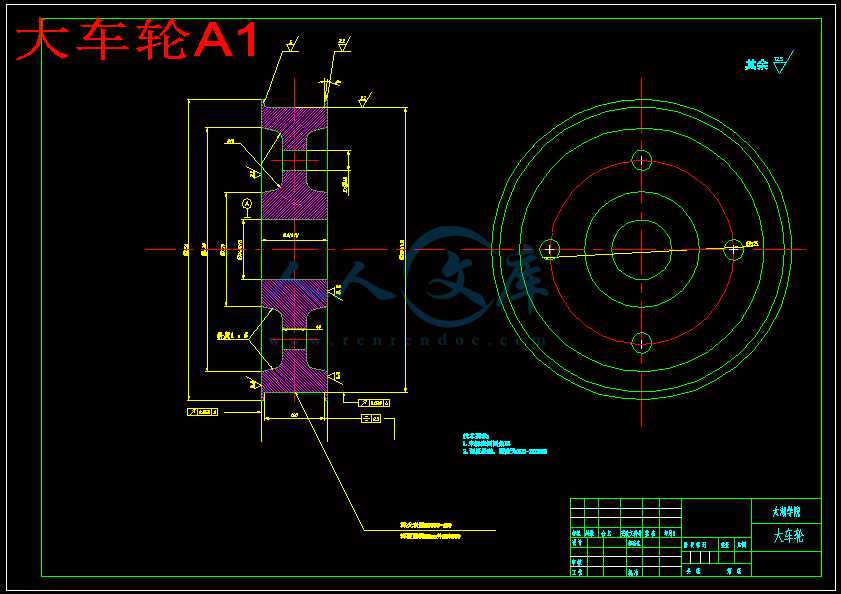【温馨提示】 购买原稿文件请充值后自助下载。
[全部文件] 那张截图中的文件为本资料所有内容,下载后即可获得。
预览截图请勿抄袭,原稿文件完整清晰,无水印,可编辑。
有疑问可以咨询QQ:414951605或1304139763











题目及专题:
1、题目 十吨位桥式起重机大车运行机构设计
2、专题
二、课题来源及选题依据
本次课程设计的课题来源于正常的生产实践需求。
选题的相关数据参数:
起重机的起重量Q=10T,
桥架跨度L=22.5m,
大车运行速度Vdc=43.8m/min,工作类型为中级,机构运行持续率为JC%=25,
起重机的估计重量G=168KN,小车的重量为Gxc=40KN,桥架采用箱形结构。
摘 要
桥式起重机是一种工作性能比较稳定,工作效率比较高的起重机。随着我国制造业的发展,桥式起重机越来越多的应用到工业生产当中。在工厂中搬运重物,机床上下件,装运工作吊装零部件,流水在线的定点工作等都要用到起重机。在查阅相关文献的基础上,综述了桥式起重机的开发和研究成果,重点对桥式起重机大车运行机构、端梁、主梁、焊缝及连接进行设计并进行强度核算,主要是进行端梁的抗震性设计及强度计算和支承处的接触应力分析计计算过程。设计包括电动机,减速器,联轴器,轴承的选择和校核。设计中参考了许多相关数据, 运用多种途径, 利用现有的条件来完成设计。本次设计通过反复考虑多种设计方案, 认真思考, 反复核算, 力求设计合理;通过采取计算机辅助设计方法以及参考他人的经验, 力求有所创新;通过计算机辅助设计方法, 绘图和设计计算都充分发挥计算机的强大辅助功能, 力求设计高效。
关键词:桥式起重机,大车运行机构,主梁,端梁,焊缝
Abstract
Bridge crane is a kind of performance is stability, the working efficiency is relatively high crane. Along with the development of China's manufacturing industry,bridge crane is applied to industrial production more and more . Carrying heavy loads in factories , machine tool fluctuation pieces, shipping work on the assembly line for hoisting parts, the designated work with a crane.On the basis of literature review, summarized the bridge crane development and research results, focusing on bridge crane during operation organization, main beam,end beam weld and connection for design and the strength calculation; Mainly for the girders extent design and strength calculation and the support of contact stress analysis program in calculation. Design including motor, reducer, coupling, bearing choosing and checking.
The design refer to many related information, reference to apply a variety of ways, make the existing conditions to complete design. By considering various design scheme repeatedly, thinking deeply,strive to design reasonable; By taking computer aided design method and reference the experience of others,strive to make innovation; Through computer aided design method, graphics and design calculations give fullplay to the powerful auxiliary function, computer to design efficient.
Key words: bridge crane; during operation organization; main beam; end beam;weld
目 录
摘 要 IV
Abstract V
目 录 VI
1 绪论 1
1.1 起重机背景及其理论 1
1.2 实际意义 1
1.3 研究现状及存在问题 1
1.4 起重机国内与国外发展动向 2
1.4.1 国内桥式起重机发展动向 2
1.4.2 国外起重机的发展动向 2
1.5 桥式起重机设计的主要内容 3
2 大车运行机构的设计 5
2.1 设计的基本原则和要求 5
2.1.1 机构传动方案 5
2.1.2 大车运行机构具体布置的主要问题: 5
2.2 大车运行机构的计算 6
2.2.1 确定机构的传动方案 6
2.2.2 选择车轮与轨道,并验算其强度 6
2.2.3 运行阻力计算 8
2.2.4 选择电动机 9
2.2.5 验算电动机的发热功率条件 9
2.2.6 减速器的选择 10
2.2.7 验算运行速度和实际所需功率 10
2.2.8 验算起动时间 10
2.2.9 起动工况下校核减速器功率 11
2.2.10 验算启动不打滑条件 11
2.2.11 选择制动器 13
2.2.12 选择联轴器 14
2.2.13 浮动轴的验算 14
2.2.14 缓冲器的选择 15
3 端梁的设计 17
3.1 端梁的尺寸的确定 17
3.1.1端梁的截面尺寸 17
3.1.2 端梁总体的尺寸 17
3.2 端梁的计算 17
3.3 主要焊缝的计算 20
3.3.1 端梁端部上翼缘焊缝 20
3.3.2 下盖板翼缘焊缝的剪应力验算 21
4 端梁接头的设计 22
4.1 腹板和下盖板螺栓受力计算 22
4.2 计算螺栓和焊缝的强度 24
4.2.1 螺栓的强度校核 24
4.2.2 焊缝的强度校核 24
5 焊接工艺设计 26
6 结论与展望 30
致 谢 31
参考文献 32
1 绪论
1.1 起重机背景及其理论
桥式起重机是架设在高架轨道上运行的一种桥架型起重机,又称为天车。桥式起重机的桥架沿着铺设在两侧的高架轨道纵向运行,起重小车沿着铺设在桥架上的轨道横向运行,构成覆盖一定面积的工作区域,这样可以充分利用桥架下面的空间吊运、装卸货物,不受地面设施、货物的阻碍。桥式起重机广泛地应用在室内外仓库、厂房、机场、港口和露天货物场所等处。二十世纪以来,随着钢铁、机械制造业和铁路、港口、航空运输及交通业的的发展,大大的促进了起重运输机械行业的发展。对起重运输机械的性能也提出了更高的要求。现代起重运输机械担当着繁重的货物搬运任务,是工厂、港口、货运铁路等工作部门实现货物搬运、装卸现代化、机械化的关键。因而起重机的金属结构都用质量可靠的钢材制造,并用焊接代替铆接,不但简化机构,缩短了制造时间,而且大大地减轻了自身的重量,焊接结构是现代金属结构的特征。我国是应用起重机械最早的国家之一,我们的祖先采用杠杆搬运石料建造城墙,就是利用起重设备节省人力、装卸货物的例子。几千年的封建统治和近代革命战争的影响,我国工业基础薄弱,自行设计制造的起重机械很少,绝大多数起重运输机械需要依靠进口。新中国成立以来,随着冶金、钢铁工业的发展,起重运输机械也获得了很好的发展,全国刚解放就建立了全国最大的大连起重机械厂,1949 年10月,在该厂试制成功我国第一台起重量为50 吨,跨度为22.5m 的桥式起重机。为培养起重运输机械专业的人才,多所高等工业学校,创办了起重运输机械专业。到目前为止,我国通用门式起重机和工程起重机已摆脱了仿制进口,完全有能力设计制造各种大型先进的起重设备。无论从结构形式,还是性能指针都达到世界领先水平。
1.2 实际意义
我国起重运输机械行业从新中国成立后开始建立并逐步发展壮大,并已形成了各种类型的产品范围和庞大的企业群体,服务于国家经济各个行业。改革开房以来,随着我国经济的快速发展,我国的起重运输机械制造业也取得了长足的进步。目前起重机械销售应用市场的前景非常广阔,2011年度起重运输机械行业销售额达到2730亿元,“十一五”期间平均每年超过15%,20112年度市场依然保持着持续增长的态势。
70年代以来,起重机的类型、规格、性能和技术水平都获得了极大的发展,除了满足国内经济建设对起重机日益增长的需要外,还向国外出口各种类型的高性能、高水平的起重机。由此可见,起重机的设计制造,也能从一个方面反映出一个国家的工业现代化水平。
1.3 研究现状及存在问题
上个世纪70年代以来,随着生产力和科学技术的发展,起重机械无论在类型及质量上都得到了极其迅速的发展。随着国民经济的快速发展,特别是国家加大基础工程建设的结构部件和机械设备的重量也越来越大,特别是大型水电站、石油、化工、港口、冶金、航天以及公用民用高层建筑的安装作业的迫切需要,极大的促进了起重机、特别是大型起重机的发展,起重机的设计制造技术得到了迅速发展。随着起重机的使用频率、起重量的增大,对其安全性能、经济性能、效率以及耐久性能等问题,也越来越引起人们的重视,并对设计理念、方法及手段的探讨也日趋深入。由于在起重机设计中采取常规设计方法时,许多构件存在不合理性,进而影响整个设备性能。随着计算机技术的应用,在很大范围内解决了起重机的设计中遇到的一些问题,尤其是有限元分析方法与计算机技术的结合,为起重机结构的准确分析提供了强力的有效手段,在实际工程已日益普及,且今后的结构分析从孤立的单个构件转变到整体结构系统的整体空间分析。
1.4 起重机国内与国外发展动向
起重机作为一种古老的机械,时至今日,在其承载方式、驱动装置、取物机构、控制方法及安全等方面上都有了完善的发展,其设计理念、制造工艺、检测方法等都日趋规范、完善,已经成为安全可靠的机械。随着生产力发展,起重机的种类、形式也需要相应地发展和创新,性能也需要不断加强与完善。随着现代化设计方法的建立,以及计算机辅助设计等现代设计手段的广泛应用,起重机设计理念和方法得到了进一步的发展,其它技术领域和相邻工业部门不断取得的新科技成果在起重机上不断的渗透、推广应用等,使得起重机的各方面都不断地发得到展。因此,起重机向现代化、智能化、数字化、更安全可靠方便的方向不断发展。
1.4.1 国内桥式起重机发展动向
加入世贸组织后,虽然国内市场(特别是配件)将受到较大冲击,但同时也给我们带来了大量的新技术,使国内主要起重机械生产企业更深刻认识到差距,更深刻地了解国产起重机械存在的致命问题,引导主要起重机械设备生产企业的进行进一步的技术创新。随着机械起重产品十多年来随着技术的引进、消化、吸收,有了长足的进步,产品性能、可靠性、外观都有较大幅度的改善和提升,但同国外同类型产品比较来看,仍然存在较大差距,就工程起重机而言,今后的发展主要表现在如下几个方面:
 川公网安备: 51019002004831号
川公网安备: 51019002004831号